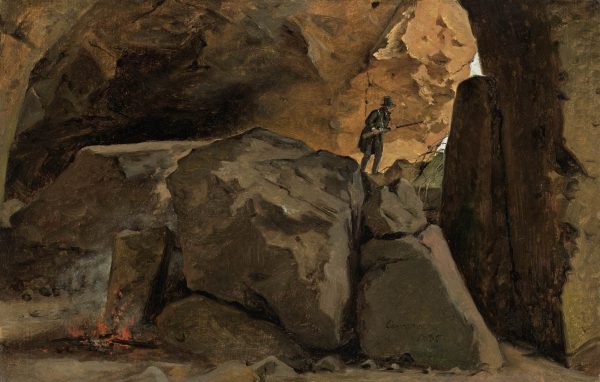A Hunter’s Lair, Cervara 1835, 1835
Oil on paper, laid down on card., H. 0.199 m; W. 0.311 m
Inscribed and dated lower right Cervara 1835.
Annotated on the stretcher in chalk 186.
Provenance: Martinus Rørbye Estate Sale, Copenhagen, 1849, no. 33
Christian Molbech, Copenhagen
Auction Sale, Winkel & Magnussen, 12/10 1942, lot 232: Jæger i en klippehule, Cervara
Auction Sale, Charlottenburg, 6.6.1944, lot 186.
- Kunstakademiets Fotosamling: a photograph of the oil sketch with reference to an exhibition in 1905 and the Charlottenburg sale in 1944.
- Fortegnelse over M.Rørbyes Arbejder som Vejledning ved Udstillingen i Kunstforeningen 1905, Copenhagen 1905, no. 226.
- L. Bobé (ed.), Rom og Danmark gennem Tiderne, III.1, Copenhagen 1935-42, ill. p. 23.
- Martinus Rørbye 1803-1848, exhib. cat., Copenhagen, Thorvaldsen Museum, 1981, p.214, M. 100: 1835 Klippehule ved Cervara, Auktion 1849, nr.33, solgt til Molbech.
Martinus Rørbye is considered a leading exponent of Danish painting of the Golden Age. He was a pupil of Cristoffer Wilhlem Eckersberg in Copenhagen, with whom he remained in close contact over many years. He undertook extensive study trips, travelling to Norway, France (Paris), Greece, Turkey and, in particular, Italy which he visited three times.
He spent the years 1834-5 – his first visit to Italy – in Rome and Naples. He was in Greece and Turkey from October 1835 to May 1836 and returned north through Italy to Munich, Vienna and Prague before reaching Dresden where he visited Johan Christian Dahl. He travelled on to Berlin, visiting Christian Daniel Rauch, and returned to Copenhagen via Hamburg and Kiel. He was in Italy for a second time in 1839 to 1841, visiting Capri and Sicily.
This oil sketch was executed on his first visit to Italy. It documents his interest and skill in capturing light effects when painting en plein air. He was fascinated by the landscapes of Italy and recorded his impressions in a series of highly expressive oil sketches. He was also drawn by the costumes and traditions of the people, the local colour and the special characteristics of the places he encountered on his travels. He frequently portrayed his travelling companions in a natural setting, using views of the countryside as a landscape background. A good example is the portrait of his friend C. J. A. Philipsen, set in a view of the Roman Campagna, in his painting Roman Campagna near Aqua acetosa.
Many artists and travellers to Rome were keen huntsmen. Good examples were Johann Martin von Rhoden and Johann Christian Reinhart. It is therefore probable that the hunter depicted by Rørbye in the present oil sketch was one of his travelling companions. The cave near Cervara may well have served as a convenient hide-out for the hunt. Rørbye was clearly drawn by the unconventionality of the speleological motif, but his real interest lies in the effects of light and the capturing of tonal transitions. The rugged surfaces of the boulders are masterfully modelled. Light from the mouth of the cave infuses the massive rock formations deep within it in a subtle play of contrasts. The composition is reminiscent of an early work by his mentor Eckersberg entitled Ulysses Flees from the Cave of Polyphemus, dated 1813.
